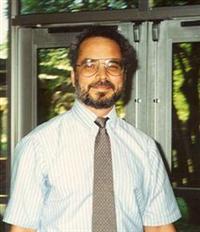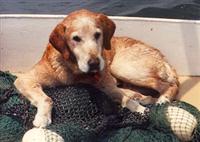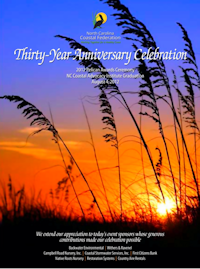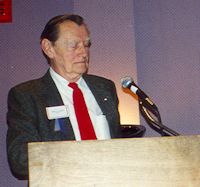First of two parts
Reprinted from the Tideland News
NEW BERN — Thirty years ago, when the staff and members of the N.C. Coastal Federation sat down for lunch, it was a pretty simple affair. Founder and executive director Todd Miller, then dark-haired and bespectacled, probably plopped down with a sandwich in his “office” on the back porch of his parents’ house overlooking Bogue Sound in the Ocean community off N.C. 24 in Carteret County.
Supporter Spotlight
His primary sounding board – heck, most likely his only sounding board most days – was Kwawk, his faithful dog.
 Todd Milller needed a job in 1982 when he started the N.C. Coastal Federation. |
 Miller’s faithful companion Kwawk was the federation’s first staff member. |
Saturday, when Miller – his still-trim beard now salt-and-peppered and his glasses traded in for contacts – ate lunch with staff and members during the federation’s 30th birthday bash, they dined on catered seafood in the N.C. History Center at the historic Tryon Place in New Bern.
There are now more than 10,000 federation members across North Carolina and the nation, and offices in Ocean, Wrightsville Beach and Manteo.
“I’d been out of school (UNC-Chapel Hill) for about a year,” Miller said last week when asked about the federation’s origin. “I had worked at UNC for a while (city and regional planning) and had been doing a lot of research on watersheds and effective management programs, and I was trying to decide what to do. I needed a job. And I wanted to find a way to stay here on the coast and help protect it.”
That memory, Miller recalled during Saturday’s celebration, is now more than a little bittersweet, as he was clamming in Bogue Sound with his father, Ted, who died last month at age 98, when the eureka-as-necessity moment occurred.
Supporter Spotlight
Clamming, he said Saturday, voice choking a bit with emotion, is one of the few activities in life that can be both productive and a relaxing opportunity for reflective pondering.
Miller and his father were floating around and casually digging up dinner with toes and fingers and talking about what Todd would do in the wake of graduation. He had turned down a job in Florida – a good match with his degree – working on water quality and planning issues. It was nearly perfect, but he didn’t really want to live on a polluted bay, and didn’t want to leave Ocean, where Bogue Sound was relatively pristine but facing increased pressure as North Carolina’s central coast was becoming a bigger blip on developers’ radar screens.
Miller had noticed that although there were a number of local environmental groups – Carteret County Crossroads, the Neuse River Foundation in New Bern and the Pamlico-Tar River Foundation – working to protect coastal water quality, there was no “umbrella” organization, nothing to tie those efforts to together and mobilize people to act on a larger scale. It was occasionally very effective, but it was uncoordinated.
 Click to view the anniversary program. |
So, with seed money from one of his professors at UNC, Miller and others convened a meeting, sort of a strategy and brainstorming session, to explore ways to remedy that situation and bring grassroots pressure to bear on coastal problems.
“The idea was to find a way to be more effective, to have a coastwide presence and get more people involved. Nobody said it was a bad idea, so I decided to try it,” Miller said.
There were, of course, successful models elsewhere, such as the Chesapeake Bay Foundation, that had been around for a while and were effectively working in similar roles. And North Carolina in 1974 had established a Division of Coastal Management and the Coastal Resources Commission, an appointed policy-making board that met regularly. The DCM and CRC were charged with protecting natural resources in the state’s 20 coastal counties, and Miller decided that was a good model for the scope the fledgling federation.
CRC meetings, he knew, would provide a forum in which coastal environmental advocates could participate.
The first step, he said, was to establish a board of directors of key coastal residents. One of the first who agreed to serve was the late John Costlow, former mayor of Beaufort and then director of the Duke University Marine Laboratory. Costlow – and others like him – “gave an unknown like me some credibility,” Miller said.
And the presence of a scientist like Costlow, along with Miller’s natural predilection for calm and reasoned debate – helped set the tone for the group: rational, sometimes even scholarly, but not stuck in the ivory tower of academia; well-versed and armed with facts but not overly didactic; passionate but not hysterical; and most of all, perhaps, practical, down-to-earth and inclusive.
 The late John Costlow gave credibility to the fledgling federation. |
One thing the federation did not have was money.
“One of the first things we had to do was try to find some resources,” Miller said. He knew that enthusiasm was both important and infectious, but funds were essential. He also knew he had to make a living.
With guidance from others who knew more than he did, Miller began seeking grants. “We were lucky enough to get one from the Mary Reynolds Babcock Foundation,” he recalled.
The $20,000 grant was approved in November 1982 and the money became available in January 1983. Miller had $8,000 from other sources and that pretty much was the budget. Miller then went on the payroll. This year, the budget is about $1.7 million. The staff – which for years was just Miller, scientist Jim Kennedy and development director Donna Agnew – has grown to 21.
Thursday: 30 years of achievements








